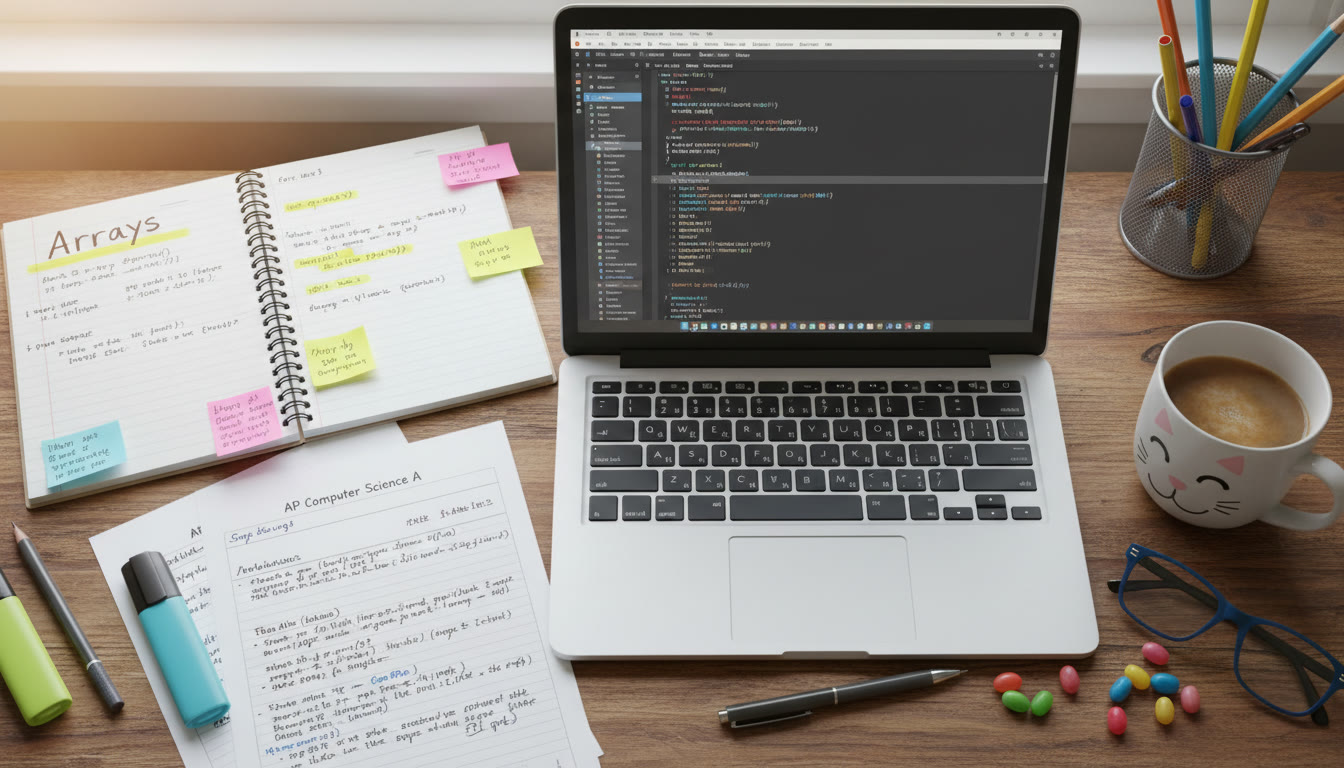Why Arrays and ArrayLists Matter on AP CSA FRQs
If you’ve spent any time with AP Computer Science A, you already know arrays, ArrayLists, and 2D arrays show up again and again on free-response questions. The College Board loves testing how you think about collections: traversals, accumulation, condition checks, transformations, and edge cases. But beyond rote memorization, exam readers are looking for clarity, correctness, and code that demonstrates consistent logic. This article will give you patterns, examples, and a practical approach so you can answer FRQs with confidence.

What the Exam Expects — The Big Picture
Free-response questions on arrays typically assess your ability to:
- Traverse collections (simple loops, nested loops for 2D arrays).
- Maintain and update accumulators (sums, counts, maxima/minima).
- Create and return new arrays or modify existing ones.
- Respect edge cases (empty arrays, null elements, odd sizes).
- Follow the method signature and not print — return values or modify parameters as specified.
Grading rubrics reward correct, readable logic first. Clean structure — clear loop boundaries, well-named variables, and careful indexing — goes a long way. Small mistakes like off-by-one errors or mixing up row/column indices on a 2D array are common and often avoidable with simple checks.
Core Patterns You Should Memorize
Instead of trying to memorize dozens of special-case tricks, get comfortable with a handful of reliable patterns. Each pattern below is concise and transferrable to many FRQs.
1. Single-Pass Accumulator Pattern
Use when you need a sum, count, average, or to detect existence.
- Loop once through array or ArrayList.
- Update accumulator based on a condition.
- Return result or compute final value after loop.
Example idea: count how many entries are positive. Keep your accumulator as an int and increment inside an if block.
2. Find-Or-Transform Pattern
Used when searching (first match) or converting elements (map-like).
- For find: loop until you find a match, then return immediately.
- For transform: create a new array or modify in place while iterating.
Tip: If the prompt asks for creating a new array of specific length, allocate first and fill by keeping a secondary index.
3. Two-Pointer / Sliding Window
Great for tasks like checking pairs, merging, or building subarrays meeting a condition. While not every FRQ requires two pointers, when you do need to work with pairs or contiguous subranges efficiently this pattern shines.
4. Nested Traversal for 2D Arrays
Almost every 2D array question reduces to a double loop. Decide which dimension is ‘outer’ vs ‘inner’ depending on logic (row-major vs column-major), and write loops like:
for (int r = 0; r < grid.length; r++) {
for (int c = 0; c < grid[r].length; c++) {
// logic
}
}
Careful: if the problem uses ragged 2D arrays (rows of different lengths), always reference grid[r].length rather than a fixed column count.
5. Build-and-Return Pattern
Many questions want you to create and return a new array or ArrayList. Think about two indexes: one for the source and one for the destination. Especially when filtering elements, the destination index increments only when you place an element.
Concrete Examples and Walkthroughs
Below are hands-on examples modeled after typical AP CSA FRQ styles. For each example, read the prompt style, write the approach in English, then code. During the exam, a 30–60 second plan can prevent mistakes and save time.
Example 1 — Count and Transform (Array)
Prompt style: Given an array of integers, return a new array containing only the positive numbers in the same order.
Plan:
- First pass: count positives to size the result array.
- Second pass: copy positives into result with destination index.
| Step | Action |
|---|---|
| 1 | Traverse to count positives (nPos) |
| 2 | Create int[] out = new int[nPos] |
| 3 | Second traversal, place positives at out[idx++] |
This two-pass approach is safe and simple — and the graders expect exactly this kind of clear logic.
Example 2 — Modify In-Place (ArrayList)
Prompt style: Given an ArrayList
Plan:
- Iterate from end to start to avoid index shift problems when removing elements.
- When encountering an empty string, call remove(i).
Why reverse? Removing an element shifts subsequent items left; iterating backwards avoids skipping items or needing a secondary index.
Example 3 — 2D Array Traversal (Count Neighbors)
Prompt style: Given a 2D int grid, for each cell compute how many of its orthogonal neighbors (up, down, left, right) have a larger value, and return a new 2D array of same size with counts.
Plan:
- Create result with same dimensions.
- Nested loops over rows and columns.
- For each cell, check up to four neighbors using boundary checks.
- Store count in result[r][c].
Edge-case note: for edge cells you will check fewer neighbors; ensure you don’t access grid with out-of-bounds indices.
Common Pitfalls and How to Avoid Them
After doing many practice FRQs, several recurring mistakes are clear. Here’s how to fix them.
Off-by-One Errors
- Always check loop bounds: for (int i = 0; i < arr.length; i++) not i <= arr.length.
- When converting between counts and indices, remember that if you counted n items, valid destination indices are 0..n-1.
Misreading Method Signatures
The FRQ will specify return types or whether to modify parameters. Take 10 seconds to underline the method signature so you don’t accidentally print results or return the wrong thing.
Mixing Up Rows and Columns
For 2D arrays remember the first index is row: grid[row][col]. A mental note like “rows go down, columns go across” helps when writing nested loops.
Nulls and Empty Collections
Unless the prompt says inputs are non-null, consider adding guards like if (arr == null) return … or if (list.size() == 0) return … when the rubric expects handling of empty cases.
Scoring Tips — What Readers Look For
Understanding scoring helps you prioritize what to get right under time pressure.
- Correct algorithmic approach: If you show the correct idea (e.g., count then build), you often get substantial credit even if a small indexing bug remains.
- Adhere to method signature and return type — failing this can lose many points.
- Edge-case handling can separate a 3 from a 4 or 5 — show that you thought about empty arrays or single-element arrays if reasonable.
- Readable variable names and brief comments can make your logic obvious to the reader and reduce the chance of misinterpretation.
Quick Checklist to Run Before Submitting
- Does your method match the signature exactly (name, return type, parameters)?
- Did you return the correct type and not print?
- Did you handle empty or null inputs if the problem suggests they may exist?
- Are your loops within bounds and do you avoid off-by-one errors?
- Are indices used consistently (row vs column)?
Practice Strategy — How to Turn Knowledge into Points
Practice is the engine; smart practice is the fuel. Here’s a study plan to structure your prep in a way that mirrors the exam’s demands.
Weekly Plan (6 Weeks)
| Week | Focus | Activity |
|---|---|---|
| 1 | Core Traversals | Do 10 single-pass array problems. Time yourself. Review mistakes. |
| 2 | ArrayList and In-Place Changes | Practice adds/removes, copy vs modify, two-pointer problems. |
| 3 | 2D Array Basics | Do neighbor, region, and transpose problems. Focus on nested loops. |
| 4 | Edge Cases and Defensive Coding | Practice null/empty handling and ragged arrays. |
| 5 | Full FRQ Practice | Complete past FRQs (timed), then compare to scoring rubric or trusted model answers. |
| 6 | Review and Polish | Fix patterns you get wrong, polish handwriting/readability, simulate test day. |
One important note: when you practice, do a quick self-critique after each question. Ask: Was the approach obvious? Is there a clearer or simpler loop? Did I catch edge cases?
Sample FRQ Response Template
Having a mental template can speed up writing under time pressure. Use this structure:
- 1–2 line English plan at the top: Explain your approach briefly.
- Write the method signature exactly as specified.
- Edge-case guard(s) immediately after signature if needed.
- Main logic with clear loops and small helper variables.
- Return statement and, if helpful, a one-line comment summarizing the result.
Why Write a Plan?
Even one or two sentences in English helps the reader award method-level points if your code later contains a small bug. It also clarifies your own mind and reduces the chance you’ll go down a wrong path.
How to Use Sparkl’s Personalized Tutoring to Sharpen Array Skills
Practice is best when it’s focused and feedback-driven. Personalized tutoring — like 1-on-1 guidance from an expert who reviews your FRQs, tailors practice problems to your weak spots, and helps you build a timing strategy — can accelerate improvement. Sparkl’s approach combines tailored study plans, expert tutors who know AP CSA expectations, and AI-driven insights to highlight recurring mistakes in your submissions. If you’re juggling school and practice time, a study plan built around your schedule keeps progress steady and measurable.
Example Walkthrough: Full Problem and Solution Outline
Let’s walk through a slightly longer example so you can see the thought process.
Prompt Style (Typical):
Write a method public static int[] frontAndBack(int[] nums) that returns a new array containing the first and last element of nums. If nums has only one element, return an array with that element twice. If nums is empty, return an empty array.
Plan (English):
- If nums.length == 0, return new int;
- If nums.length == 1, return new int[]{nums, nums};
- Otherwise return new int[]{nums, nums[nums.length – 1]};
Why this is good:
It handles edge cases explicitly, uses constant time and constant space (new array of size 2), and follows method-signature requirements. The logic is straightforward and easy to grade.
Timing and Exam Day Tips
On exam day, time management can make or break your performance on FRQs. Here’s how to allocate attention effectively.
- Read all FRQs first and mark which ones look straightforward (arrays often are!).
- Start with the question you’re most confident on — earn secure points early.
- For array questions, spend 30–60 seconds planning in English. Write that plan down.
- If you get stuck on an indexing detail, write a comment explaining your intent. Readers may award partial credit for correct approach.
Quick Reference: Small Code Patterns (Pseudocode)
Keep these short patterns in your study notes; they’re exam-ready in both clarity and brevity.
| Task | Pseudocode |
|---|---|
| Count positives | int count = 0; for (x : arr) if (x > 0) count++; |
| Copy positives to new array | int k = 0; for (i…) if (arr[i] > 0) out[k++] = arr[i]; |
| Remove from ArrayList safely | for (int i = list.size()-1; i >=0; i–) if (condition) list.remove(i); |
| 2D neighbor check | for r: for c: check r-1,r+1,c-1,c+1 if within bounds |
Wrapping Up: Confidence Over Panic
Arrays, ArrayLists, and 2D arrays are predictable. The examiners rarely try to trick you with exotic data structures in an AP CSA FRQ; they want to see clean logic, careful indexing, and correct edge-case handling. Build reliable patterns, practice them under timed conditions, and write a short plan before coding.
If you find yourself stuck or you want structured feedback, consider adding focused support — like Sparkl’s personalized tutoring — to your study routine. A few targeted sessions that review your FRQ answers, strengthen weak patterns, and provide a tailored study plan can turn repeating mistakes into steady score gains.

Final Exam Checklist
- Underline the method signature and required return type.
- Write a 1–2 sentence plan before you code.
- Handle trivial edge cases explicitly (empty, size 1, null if indicated).
- Keep loops simple and comment tricky index calculations.
- Run a quick mental test on a small example (e.g., array size 0, 1, 2, and a typical case).
Mastering arrays for AP CSA free-response is a mixture of pattern recognition, careful detail work, and smart practice. Use the patterns here, practice deliberately, and consider guided support when you need fast improvement. You’ll get better not by cramming, but by practicing the right way and learning to communicate your logic clearly — which is exactly what exam readers reward.
Good luck — you’ve got this.




















No Comments
Leave a comment Cancel